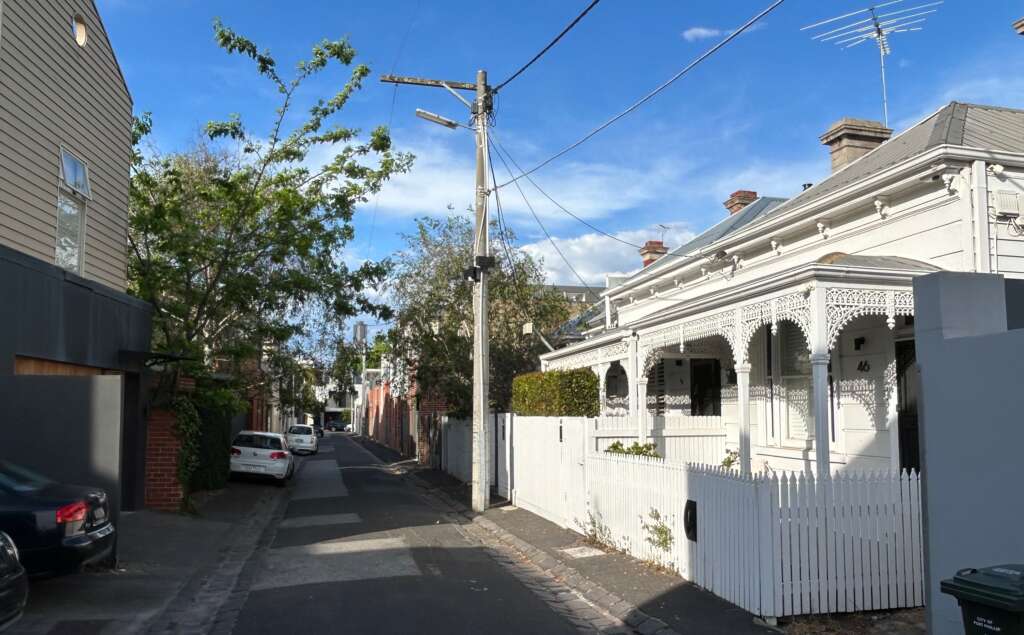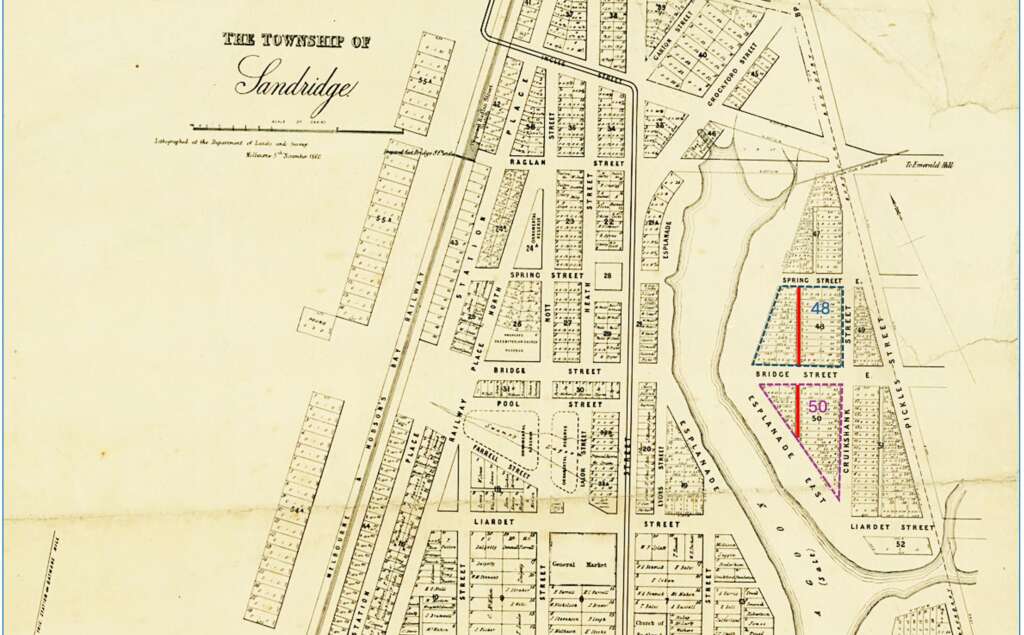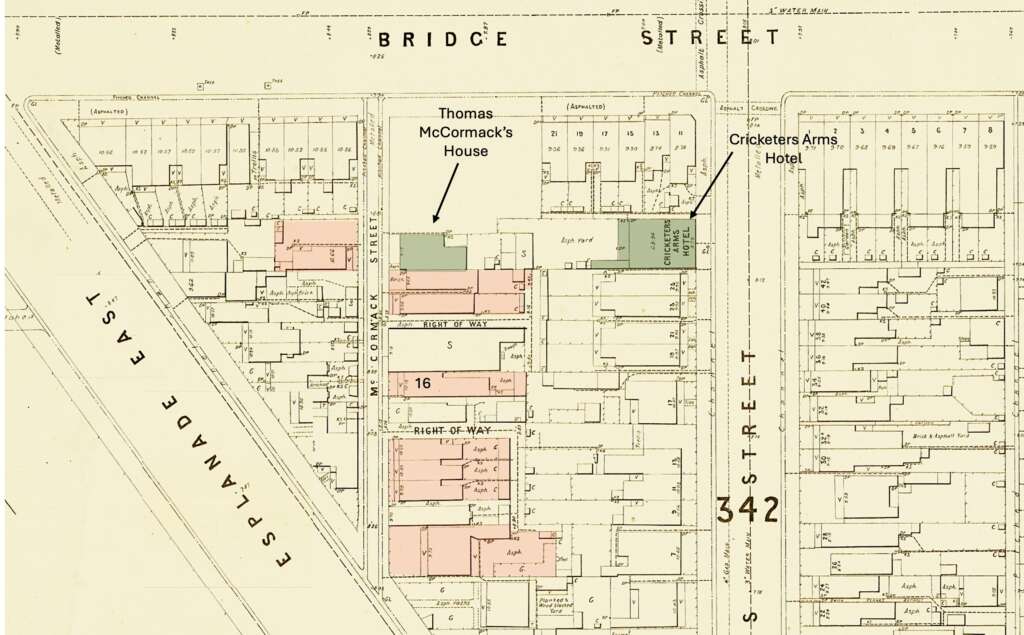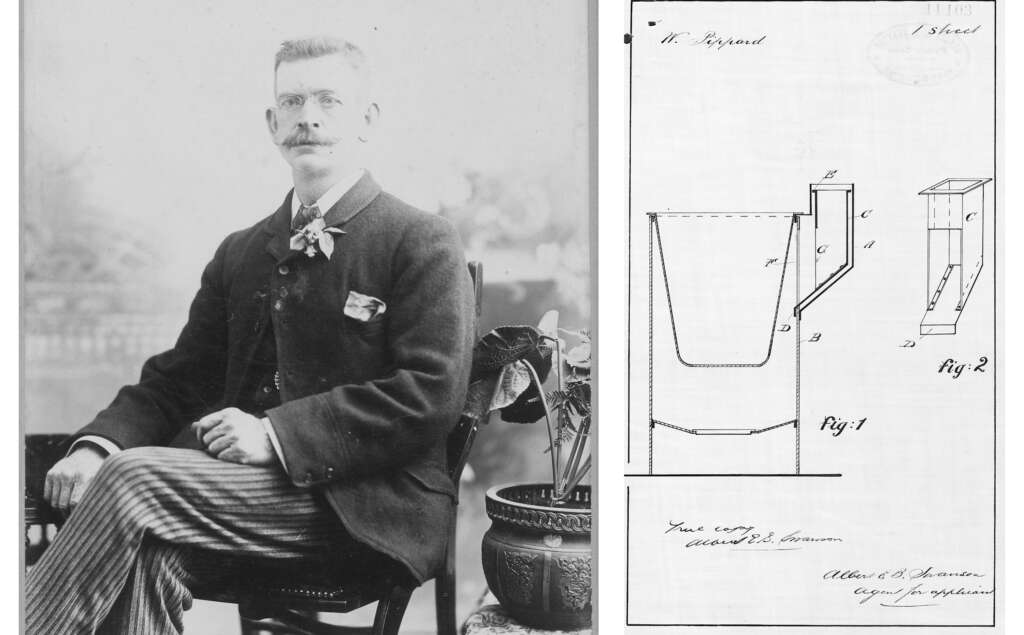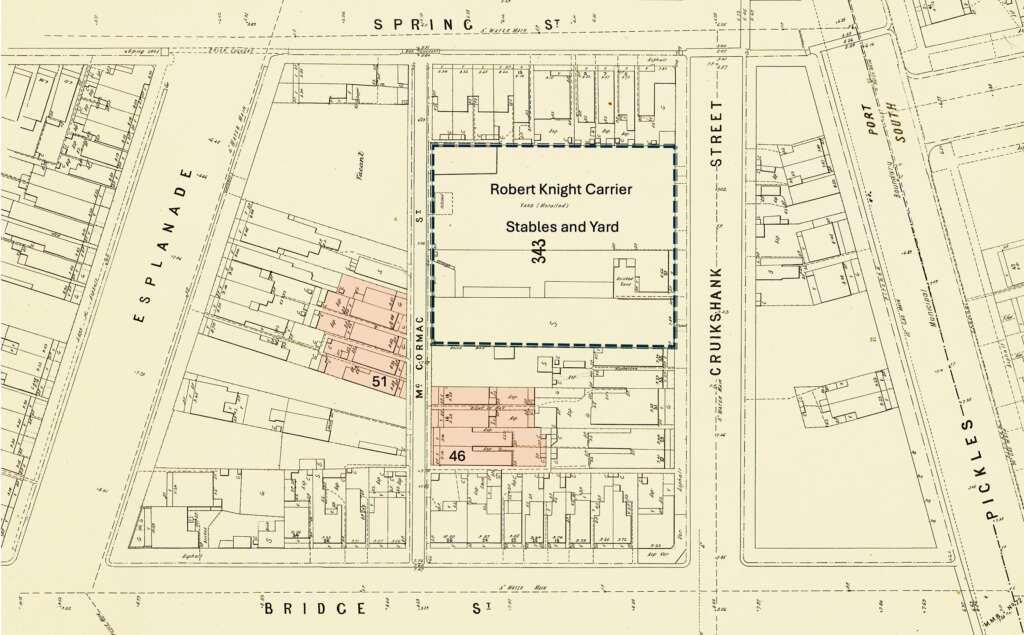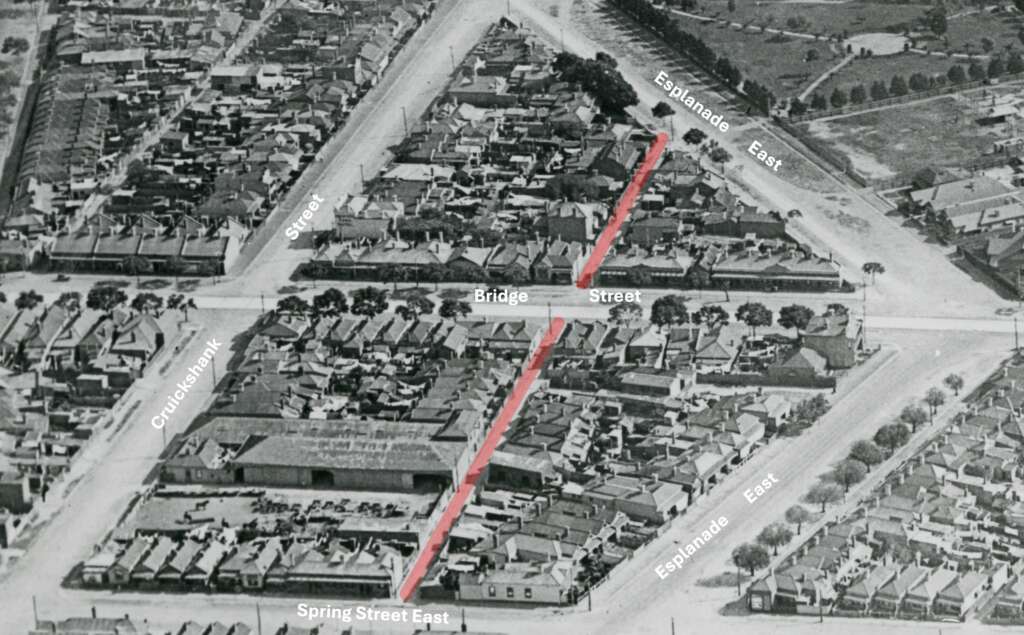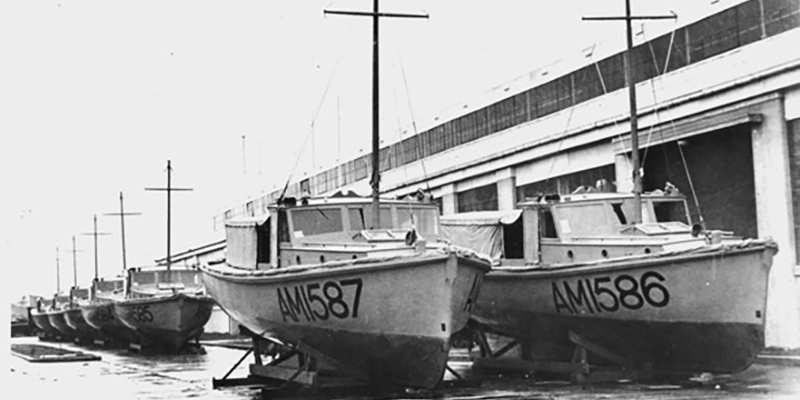McCormack: A Slender Street in Two Parts
by David F Radcliffe
In her 2014 article on McCormack St, Robyn Clinch sketched the life of publican Thomas McCormack, after whom the street was named. The McCormack family lived on the southern part of this slender street between Bridge Street and Esplanade East. McCormack Street also extends northward from Bridge Street to Spring Street East. Each part has a distinct ambience.
Although it is called a street, McCormack was designed as a right-of-way providing rear access to building allotments on Esplanade East and Cruickshank Street. These two major streets, together with Bridge Street and Spring East Street, formed the boundaries of Crown Land sections 48 and 50 located on the eastern shore of Sandridge Lagoon. These four streets were gazetted in 1865, and the land was auctioned during the 1870s.
In 1879, a few years after opening the Cricketers Arms Hotel on Cruickshank Street, Thomas McCormack built a two-storey brick residence at the rear of the block, fronting the right-of-way (shown in green on Section 50 plan below). The name McCormack Street first appears in the early 1880s.
Rights-of-way were never intended to have houses, but as happened across the Borough in the land boom of the 1880s, numerous small cottages sprung up on McCormack Street as the original 24 perch (607 m2) Crown Allotments were cut in two lengthwise and with many then being split down the middle and sold as 6 perch (124 m2) building sites.
In the southern part, Section 50, the shape of the Lagoon and hence the angular alignment of Esplanade East meant that all but one of the cottages on McCormack were on the eastern side of the street (pink in the plan below).
John Gilchrist recalls growing up at 16 McCormack during the 1940s, grazing draught horses on Lagoon Reserve and acting as a lookout for the SP bookies to warn them of approaching coppers.
Fifty years earlier, the occupant of number 16, engineer Samuel Pippard, was focused on a different sort of ‘copper’. In 1893, he developed an improved process for making copper boilers, the washing machine of the day. By forming the bowl of the ‘copper’ from a single metal sheet using a hydraulic press, he eliminated the need for rivets. The dies he designed to do this were cast at Tarver Brothers Foundry in Stoke Street.[1] The Standard also credited him with a patent for improving the frame that held the copper bowl and the flue.[2] Curiously, his brother William, a blacksmith who lived in Raglan Street, is credited with what appears to be this patent.[3]
On the northern half, Section 48, the shallower angle of Esplanade East led to a more even distribution of small cottages on both sides of McCormack. As the 1894 MMBW plan below shows, large tracts of Section 48 remained vacant. The stables and yard of carrier Robert Knight occupied a significant portion of the frontage on both Cruickshank and McCormack Streets.
In this narrow street with small houses cheek by jowl, any antisocial behaviour of one impacted many. The following occurred in 1927, involving Mr Kirby of 51 McCormack and the Condon family in number 46.[4]
John Kirby, an old identity of Port Melbourne, 90 years of age, was charged with using insulting words to Mrs Jane Condon in McCormack Street. Though twenty yards distant, he could be heard plainly, and the words were so bad, that they had to be written down. Mrs Condon said that the accused threatened her and was always shouting out at the women and children, mostly in lurid language.
Constable Jeffrey said he had had complaints for several months past and had frequently warned Kirby. He had also asked Kirby’s son and daughter to take action, but they refused, and Dr. Grover would not certify that he was of unsound mind. The accused thought there was a conspiracy against him and became very garrulous when asked to state his case to the Bench. He was asked if he would go into a home and promised to do so if given time. The case was adjourned for seven days.
A few years later, the Condon’s son John made the headlines. He was charged with assaulting a football umpire, J. L. Weymouth of Gladstone Street, South Melbourne, in a VFA Sub-district game between Port and South Melbourne at Albert Park. The game was a heated affair, the ground underwater and tempers were a “bit short”. Early in the second quarter, Weymouth awarded a free kick against Condon, who responded by hitting him in the face twice. Weymouth chose not to send Condon off, but the Association insisted he press charges. John was found guilty and fined £2 plus costs or 14 days in prison. However, the real penalty was his being barred from playing for four and a half years.[5]
Thomas McCormack’s two-story brick home at 26 McCormack is the only original house remaining on the southern half of the street. In 1983, that side of the street was widened and gazetted as a ‘road’.[6] Thus, today’s houses are set back somewhat compared to where 16 McCormack and neighbouring houses once stood.
In contrast, the four late Victorian wooden cottages on the eastern side of the northern part (Section 48) remain today. Although modern two-story houses have replaced the wooden ones on the other side, the footprint of the properties has not changed, so it retains the ‘feel’ of a closely occupied right-of-way of a century ago. Unlike many other narrow streets, this northern part of McCormack has as many residences as it did a century ago, not including the new properties in the complex built on the site of Knight’s yard and stable.
For more on the McCormack family, the story of ‘Ma’ McCormack, Mary Anne Bennett (1875-1946), the matriarch of the second generation of publicans, is told in Women of Port Melbourne.
[1] 1893 ‘Items of News.’, Standard (Port Melbourne, Vic. : 1884 – 1914), 4 November, p. 2. , viewed 31 Oct 2024, http://nla.gov.au/nla.news-article165168543
[2] 1894 ‘Items of News.’, Standard (Port Melbourne, Vic. : 1884 – 1914), 17 February, p. 2. , viewed 31 Oct 2024, http://nla.gov.au/nla.news-article165168057
[3] NAA: A13149, 11103 Application for registration of patent by William Henry Pippard titled – An improvement in smoke flues of portable copper washing boilers.
[4] 1927 ‘PORT MELBOURNE COURT’, Record (Emerald Hill, Vic. : 1881 – 1954), 14 May, p. 3. , viewed 31 Oct 2024, http://nla.gov.au/nla.news-article164452128
[5] 1931 ‘FOOTBALL UMPIRE ASSAULTED.’, The Argus (Melbourne, Vic. : 1848 – 1957), 18 July, p. 21. , viewed 31 Oct 2024, http://nla.gov.au/nla.news-article4402865
[6] Victorian Government Gazette, No 114, 25 November 1983, p. 3885.

